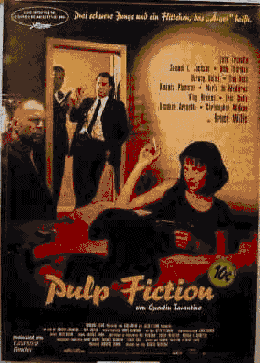|
|
|

PULP (pulp) n.
1. A soft, moist, shapeless , mass of matter
2. A book containing lurid subject matter, and being characteristically printed on rough, unfinished paper.
American Heritage Dictionary
New College Edition
Quentin Tarantino`s biggest masterwork, achieved the 1994 Cannes Film Festival Best Picture Award. In the wake of Cannes, other awards followed, including the LA Critics` Awards (Best Picture, Best Director, Best Screenplay, and Best Actor for John Travolta), the National Board of Review (Best Picture, Best Director), The New York Film Critics` Circle (Best Director, Best Screenplay), The Golden Globes (Best Screenplay), the Independent Spirit Awards (Best Feature, Best Director, Best Male Lead for Samuel L. Jackson, and Best Screenplay) and the BAFTAs (Best Supporting Actor for Samuel L. Jackson, Best Screenplay). More importantly, in February it received seven Oscar nominations (Won for best Original Screenplay), a quite staggering endorsement. The awards almost speak for them selves, Quentin Tarantino`s final breakthrough had that special something. Either you love it, or you hate it!
It is possibly the most unpopular movie ever to gross $100 million at the American box office. People who say they hate the movie, finds it too violent, too graphic, too obscene, or «makes no sense». Many say they walked out after 20, 30 or 60 minutes. (Given its circular time line, of course it made no sense to them; this is a movie where you have to wait until you can say «This is were we came in».) Among those who admire it, however, Quentin Tarantino`s film is the most passionately loved and obsessed-about film of recent years. On campuses and among younger viewers, there is no other recent film approaching its appeal.
Well, of course the title is not coincidental. In fact it refers generally to the crime stories from the 1930s and 1940s, the cheap, garishly, illustrated news-stand publications of which for instance Black Mask was one, in turn triggered the films noirs of the 1940s like The maltese Falcon, The Big Sleep and Double Indemnity.
Tarantino wanted to achieve something approximating the short story spirit of the original literature. He thus decided to use three main plot developments as the means to his end.
These are:
It is more subtle and complex than at first it seems; the Oscar-winning screenplay, by Tarantino and Roger Avary, often makes connections that only occur to you after time. The film tells interlocking stories, which unfold out of chronological order (see above). Why is the movie told in this way? For three reasons perhaps:
«The stories would be the oldest chestnuts in the world. You`ve seen `em a zillion times, alright - The guy who`s supposed to take out the boss`s lady, «but don`t touch her»; The boxer who supposed to throw the fight but doesn`t; and the third story is kind of like the opening five minutes of every Joel Silver movie -two hitmen go and kill somebody. We hang out with those two hitmen for the whole rest of the morning and we see what else happens. I love the idea that each of these characters could be the star of their own movie and, as far as they`re concerned, when they come in, they are.»
Roger Avary, CO-writer, Pulp Fiction
It all starts in a coffee shop, a young woman and a young man talking to each other, Pumpkin (Tim Roth) and Honey Bunny (Amanda Plummer) looks like a innocent couple discussing everyday topics, but in fact they are planning to rob the coffee shop. The setting is The Hawthorne Grill, west Los Angeles. The atmosphere is quiet and their dialogue is to be said in a rapid-pace His Girl Friday fashion. This stage-direction, which is given in the manuscript, is like lots of other stage-directions in Tarantino`s movies, they reflects to other scenes in other movies. His Girl Friday is an American tv-series. The parts were especially written for Tim Roth and Amanda Plummer. Tarantino liked the chemistry between these two from another film, in which they played. Tim Roth is by the way, also seen in Reservoir dogs were he has a main part. Not only does the movie starts in the coffee-shop, it also ends in the coffee-shop. The young couple has a kind of prologue to the movie and an epilogue.
Back to The Quentin Tarantino Project (Hit Image)